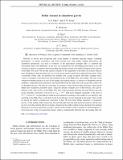Files in this item
Stellar streams in chameleon gravity
Item metadata
| dc.contributor.author | Naik, A. P. | |
| dc.contributor.author | Evans, N. W. | |
| dc.contributor.author | Puchwein, E. | |
| dc.contributor.author | Zhao, H. | |
| dc.contributor.author | Davis, A.-C. | |
| dc.date.accessioned | 2020-11-11T12:30:20Z | |
| dc.date.available | 2020-11-11T12:30:20Z | |
| dc.date.issued | 2020-10-27 | |
| dc.identifier | 271185487 | |
| dc.identifier | 36e84b41-efa0-4e3d-bbfd-eb7e0f06fc50 | |
| dc.identifier | 85094867034 | |
| dc.identifier | 000582565500013 | |
| dc.identifier.citation | Naik , A P , Evans , N W , Puchwein , E , Zhao , H & Davis , A-C 2020 , ' Stellar streams in chameleon gravity ' , Physical review. D, Particles, fields, gravitation, and cosmology , vol. 102 , no. 8 , 084066 . https://doi.org/10.1103/PhysRevD.102.084066 | en |
| dc.identifier.issn | 1550-7998 | |
| dc.identifier.other | RIS: urn:3EAC21C2D9B69D50F9623F450EC8BE99 | |
| dc.identifier.other | RIS: 10.1103/PhysRevD.102.084066 | |
| dc.identifier.other | ArXiv: http://arxiv.org/abs/2002.05738v2 | |
| dc.identifier.uri | https://hdl.handle.net/10023/20948 | |
| dc.description | APN thanks the Science and Technology Facilities Council (STFC) for their PhD studentship. HZ acknowledges support by the Kavli Foundation. ACD acknowledges partial support from STFC under grants ST/L000385 and ST/L000636. | en |
| dc.description.abstract | Theories of gravity that incorporate new scalar degrees of freedom typically require “screening mechanisms” to ensure consistency with Solar System tests. One widely studied mechanism—the chameleon mechanism—can lead to violations of the equivalence principle (EP), as screened and unscreened objects fall differently. If the stars are screened but the surrounding dark matter is not, EP violation can lead to asymmetry between leading and trailing streams from tidally disrupted dwarf galaxies in the Milky Way halo. We provide analytic estimates of the magnitude of this effect for realistic Galactic mass distributions, demonstrating that it is an even more sensitive probe than suggested previously. Using a restricted N -body code, we simulate four satellites with a range of masses and orbits, together with a variety of strengths of the fifth force and screening levels of the Milky Way and satellite. The ratio of the cumulative number function of stars in the leading and trailing stream as a function of longitude from the satellite is computable from simulations and measurable from the stellar data and can provide a direct test of chameleon gravity. We forecast constraints for streams at large Galactocentric distances, which probe deeper into chameleon parameter space, using the specific example case of Hu-Sawicki f(R) gravity. Streams in the outer reaches of the Milky Way halo (with apocenters between 100 and 200 kpc) provide easily attainable constraints at the level of |fR0|=10−7. Still more stringent constraints at the level of 10−7.5 or even 10−8 are plausible provided the environmental screening of the satellite is accounted for, and screening of the Milky Way’s outer halo by the Local Group is not yet triggered in this range. These would be among the tightest astrophysical constraints to date. We note three further signatures of chameleon gravity: (i) the trailing stellar stream may become detached from the dark matter progenitor if all the stars are lost, (ii) in the extreme fifth force regime, striations in the stellar trailing tail may develop from material liberated at successive pericentric passages, and (iii) if the satellite is fully screened, its orbital frequency is lower than that of the associated dark matter, which is preferentially liberated into the leading tidal tail. | |
| dc.format.extent | 24 | |
| dc.format.extent | 2355072 | |
| dc.language.iso | eng | |
| dc.relation.ispartof | Physical review. D, Particles, fields, gravitation, and cosmology | en |
| dc.subject | astro-ph.GA | en |
| dc.subject | astro-ph.CO | en |
| dc.subject | QB Astronomy | en |
| dc.subject | QC Physics | en |
| dc.subject | DAS | en |
| dc.subject.lcc | QB | en |
| dc.subject.lcc | QC | en |
| dc.title | Stellar streams in chameleon gravity | en |
| dc.type | Journal article | en |
| dc.contributor.institution | University of St Andrews. School of Physics and Astronomy | en |
| dc.identifier.doi | 10.1103/PhysRevD.102.084066 | |
| dc.description.status | Peer reviewed | en |
| dc.identifier.url | https://arxiv.org/abs/2002.05738 | en |
This item appears in the following Collection(s)
Items in the St Andrews Research Repository are protected by copyright, with all rights reserved, unless otherwise indicated.

